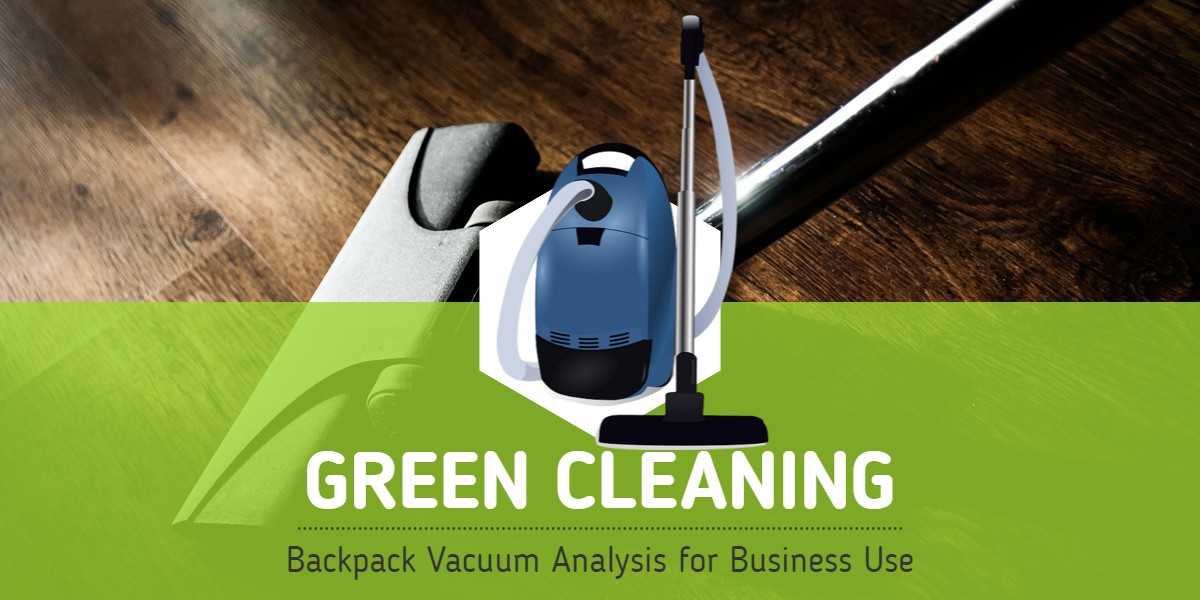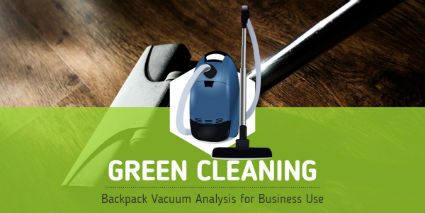A modern, technically advanced tool commonly used by green cleaning services are backpack vacuums.

An Analysis of Backpack Vacuum's in Green Cleaning Services
Green cleaning services are not just about the health and cleanliness of your office.
A critical aspect is the health, safety, and improved efficiency and productivity of the janitorial staff.
Two organizations regulate the certification of 'green' vacuum cleaners.
- The US Green Building Council's LEED-EB (Existing Building) Standards.
- The Carpet and Rug Institute Green Label Testing Program.
These organizations rate and certify vacuums according to several criteria, two of which have a direct impact on the health of the operator:
- Ergonomic Design
- Noise Pollution
The focus on more ergonomic design, combined with a reduction in noise, has been shown to significantly increase the productivity of the vacuum operator while decreasing the amount of time cleanup would take with a comparable, upright vacuum.
LEED Standards
While LEED Standards regulate the 'green applicability' of an office building all around, and only offers basic guidelines regarding the ergonomics of vacuum's, as well as deferring to The Carpet and Rug Institute's (CRI) testing for effectiveness, it is quite clear on sound levels.
LEEDEBOM calls for the purchase and use of cleaning equipment that meets the following criteria:
Vacuum cleaners are certified by the Carpet and Rug Institute Green Label Testing Program and operate at a sound level of less than 70dBA.
Green Cleaning and LEED® for Existing Buildings: Operations and Maintenance What’s the Connection?
For More Information:
The Carpet and Rug Institute
CRI has posted rigorous testing criteria for its Green Label Testing Program.
Additional testing standards are required for the Green Certification of vacuums.
These tests include:
- Evaluation of Vacuum Removal of Solid Particulate From Carpet.
- Quantifying Respirable Particulate From Vacuuming Carpet.
- Carpet Surface Appearance Change Due To Vacuuming.
- Determining the Power Use Effectiveness of Residential and Commercial Vacuum Cleaners.
CRI also maintains an updated list of certified vacuum's.
Note that, of the top 7 Gold Certified-Energy Efficient vacuum's currently listed, 4 are backpack vacuums.
The tests are meant to certify a vacuum's ability to remove dirt and other particles from the floor or carpet.
That dust and other particulate matter can have a profound impact on the health of the office workers, as well as the janitorial staff.
According to the EPA:
Particle pollution - especially fine particles - contains microscopic solids or liquid droplets that are so small that they can get deep into the lungs and cause serious health problems. Numerous scientific studies have linked particle pollution exposure to a variety of problems, including:
Premature death in people with heart or lung disease,
Nonfatal heart attacks,
Irregular heartbeat,
Aggravated asthma,
Decreased lung function, and
Increased respiratory symptoms, such as irritation of the airways, coughing or difficulty breathing.
Noise Pollution
LEED approved vacuums must not exceed a noise level above 70dB(A).
According to WebMD, this is approximately the same noise level as an office on a typical day, and less than the standard measurement for older cleaning systems; or around 75dB(A).
Noise pollution can have a profound impact on the health, well-being, and satisfaction of the operator, and those in the same vicinity as the worker when they are cleaning.
The reason is that, again, according to WebMD, any noise over 85dB(A) is considered harmful, and prolonged exposure will have an adverse impact on hearing.
However, that does not appear to be the most common cause of accumulated hearing damage.
Most cases of noise-induced hearing loss are caused by repeated exposure to moderate levels of noise over many years, not by a few cases of very loud noise.
Ergonomics
The results of a study published by The US National Library of Medicine National Institutes of Health...
[sic]...determined that cleaning workers who perform the task of vacuum cleaning are at risk of work-related upper-limb musculoskeletal injury, regardless of whether they use a back-pack or canister machine.
Government school cleaners experienced greater risk of work-related upper-limb musculoskeletal disorders than workers in either the hospitality or commercial office space sectors.
Risk of musculoskeletal injury among cleaners during vacuuming.
The fast-paced nature of outsourced janitorial services has been shown to contribute to this type of fatigue and accumulated damage.
A modern approach to scientifically backed, ergonomic design is meant to combat this.
Ergonomic studies have shown that an operator's perception of weight can be directly affected by the proximity and height of the backpack vacuum.
More specifically, the higher the pack is on the back, and the closer it is to the body, the less weight or burden is perceived by the operator, leading to increased productivity and decreased physiological strain.
The reduction in perceived strain, as well as the increase in work performance, is a direct result of the backpack vacuum's design principles.
- Weight - Most backpack style vacuum's come in at under the 13lbs maximum recommended by Michael Holewijn in the European Journal of Applied Physiology. According to the article, weight carried on the back exceeding 13lbs will have an adverse impact on lung capacity. This is especially relevant for smaller female cleaning staff. The reduction in lung capacity/function causes additional strain, increasing the total operators workload, and reducing their ability for efficiency.
- Distribution - Placing the pack high on the back significantly reduces the perception of weight and strain on the operator, lending further towards increased productivity.
- Harness - The design of the harness will have a direct impact on perceived weight and distribution, as well as combat issues with chafing after prolonged use.
- Sound - The vacuum must operate at the LEED maximum noise level of 70dB(A) to protect the hearing of the operator.
- Discharge - In the very best backpack vacuum's, the air is vented from the bottom of the pack; up and away from the operator to avoid contributing to discomfort after prolonged use.
For More Information:
Design can play a vital role in combating repetitive stress injuries common in janitorial staff and is an OSHA recommended alternative to traditional, upright vacuum's.
For More Information:
Takeaway
Advanced, green cleaning backpack vacuum technology has been shown to have multiple positive implications for janitorial workers, office staff, and the overall health of a workplace.
- Reduces perceived strain on the operator.
- Reduces lung fatigue.
- Combats hearing loss due to prolonged moderate noise exposure.
- Decreases the amount of particulate matter released into the air from the carpet during ventilation, reducing the risk of prolonged damage to the lungs, nose, and throat, as well as airborne diseases and bacteria.
- Has been shown to increase the efficiency of the operator, allowing for faster turnaround times on office cleaning.
If you would like to learn more about the benefits of green cleaning services for your business, contact us today for a free quote!
In Bakersfield CA, call 661-395-3009
In Fresno CA, call 559-473-1790

